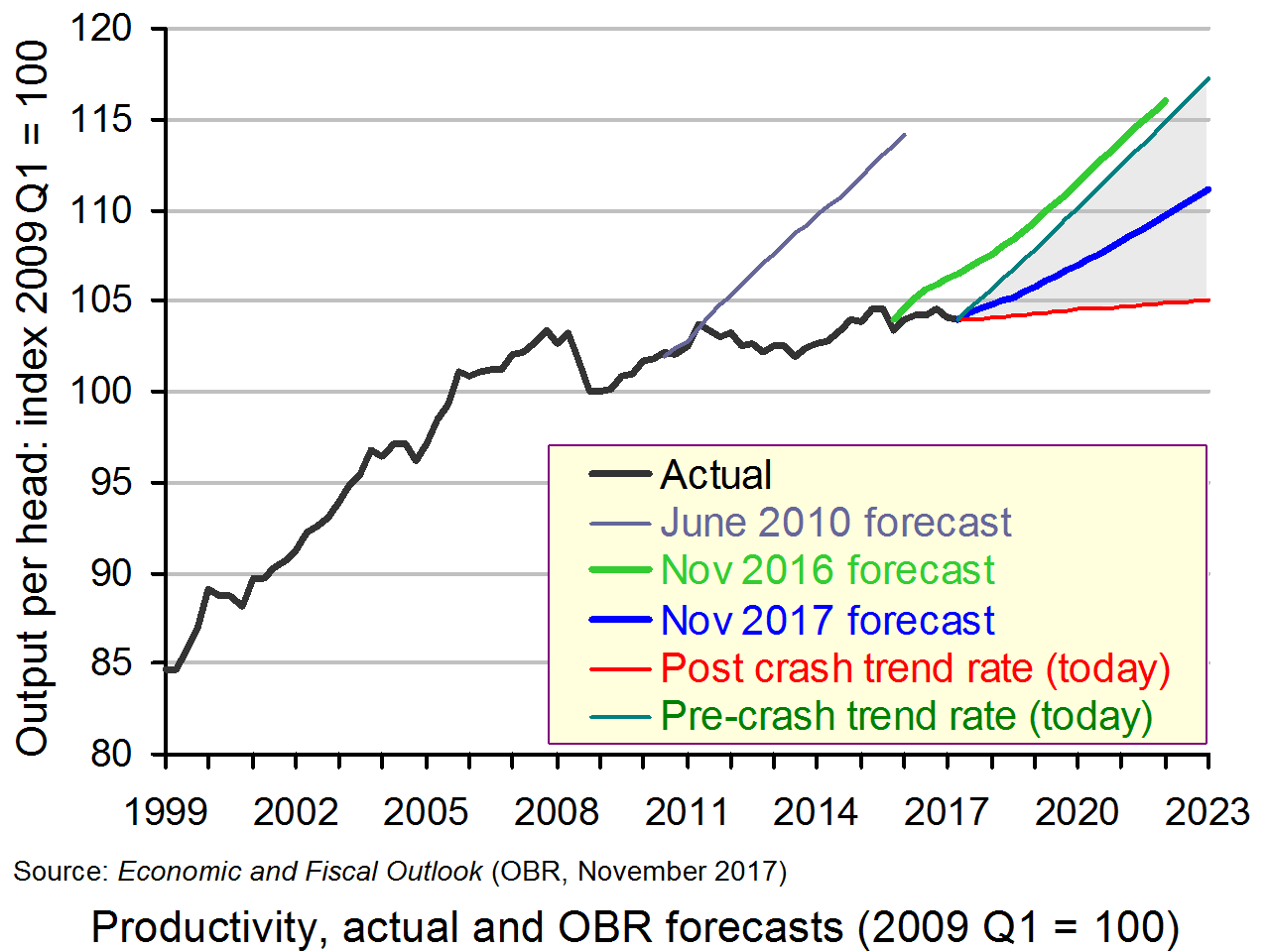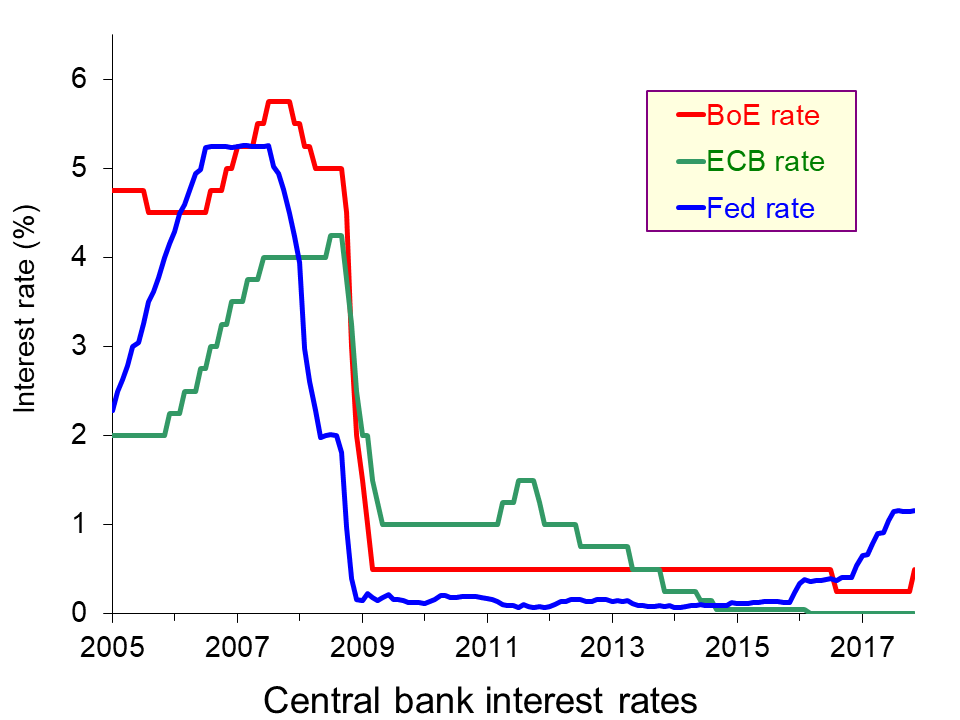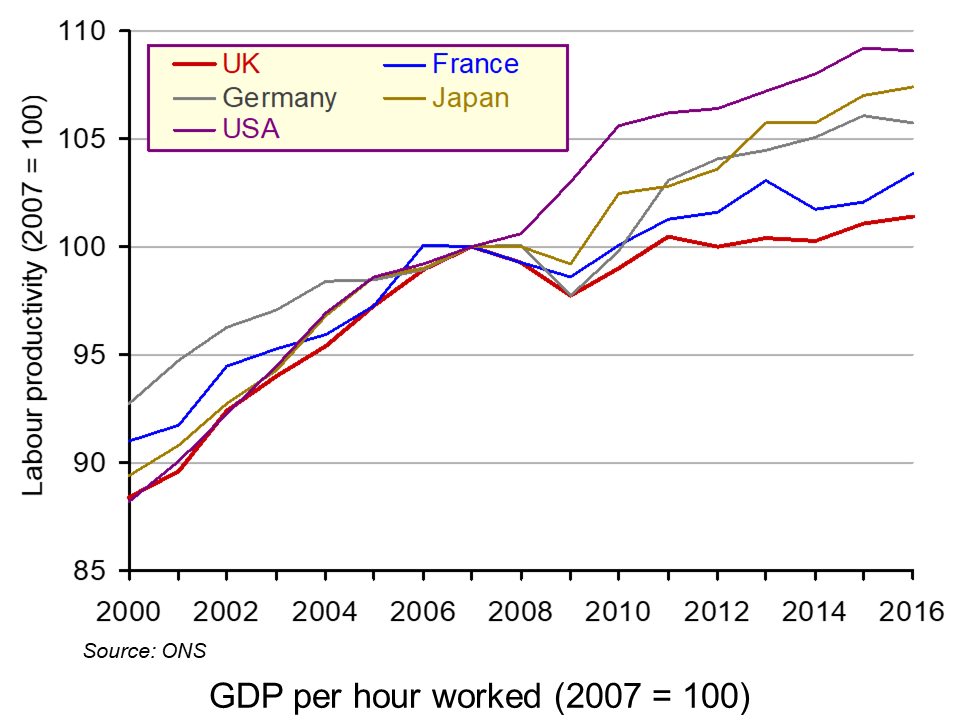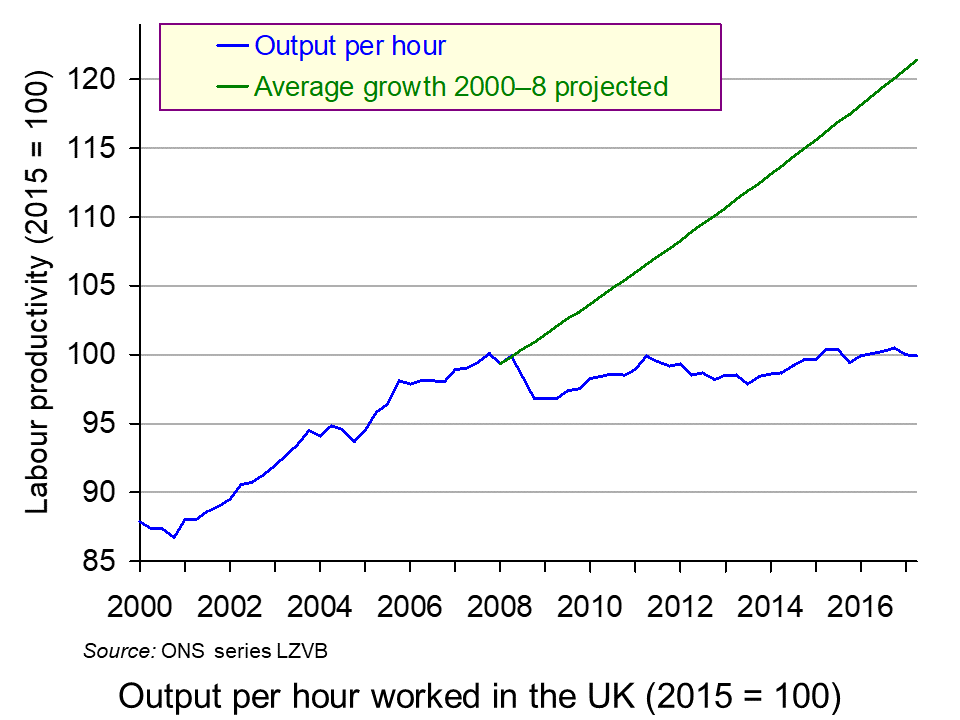 In delivering his Budget on 22 November, Philip Hammond reported that the independent Office for Budget Responsibility had revised down its forecasts of growth in productivity and real GDP, and hence of earnings growth.
In delivering his Budget on 22 November, Philip Hammond reported that the independent Office for Budget Responsibility had revised down its forecasts of growth in productivity and real GDP, and hence of earnings growth.
Today, median earnings are £23,000 per annum. This is £1500 less than the £24,500 that the median worker earned in 2008 in today’s prices. The OBR forecasts a growth in real household disposable income of just 0.35% per annum for the next four years.
With lower growth in earnings would come a lower growth in tax revenues. With his desire to cut the budget deficit and start eventually reducing government debt, this would give the government less scope for spending on infrastructure, training and other public-sector investment; less scope to support public services, such as health and education; less scope for increasing benefits and public-sector wages.
The normal measure of productivity, and the one used by the OBR, is the value of output produced per hour worked. This has hardly increased at all since the financial crisis of 2008. It now takes an average worker in the UK approximately five days to produce the same amount as it takes an average worker in Germany four days. Although other countries’ productivity growth has also slowed since the financial crisis, it has slowed more in the UK and from a lower base – and is now forecast to rebound less quickly.
Although other countries’ productivity growth has also slowed since the financial crisis, it has slowed more in the UK and from a lower base – and is now forecast to rebound less quickly.
For the past few years the OBR has been forecasting that productivity growth would return to the trend rate of just over 2% that the UK achieved prior to 2008. For example, the forecasts it made in June 2010 are shown by the grey line in the chart, which were based on the pre-crash trend rate of growth in productivity (click on chart to enlarge). And the forecasts it made in November 2016 are shown by the pale green line. Yet each year productivity has hardly changed at all. Today output per hour is less than 1% above its level in 2008.
Now the OBR believes that poorer productivity growth will persist. It is still forecasting an increase (the blue line in the chart) – but by 0.7 of a percentage point less than it was forecasting a year ago (the pale green line): click here for a PowerPoint of the chart.
We have assumed that productivity growth will pick up a little, but remain significantly lower than its pre-crisis trend rate throughout the next five years. On average, we have revised trend productivity growth down by 0.7 percentage points a year. It now rises from 0.9 per cent this year to 1.2 per cent in 2022. This reduces potential output in 2021-22 by 3.0 per cent. The ONS estimates that output per hour is currently 21 per cent below an extrapolation of its pre-crisis trend. By the beginning of 2023 we expect this to have risen to 27 per cent.
Why has there been such weak productivity growth?
Weak productivity growth has been caused by a mixture of factors.
Perhaps the most important is that investment as a percentage of GDP has been lower than before the financial crisis and lower than in other countries. Partly this has been caused by a lack of funding for investment as banks have sought to rebuild their capital and have cut down on riskier loans. Partly it has been caused by a lack of demand for investment, given sluggish rates of economic growth and the belief that austerity will continue.

And it is not just private investment. Public-sector investment in transport infrastructure, housing and education and training has been lower than in other countries. Indeed, the poor training record and low skill levels in the UK are main contributors to low productivity.
The fall in the pound since the Brexit vote has raised business costs and further dampened demand as incomes have been squeezed.
Another reason for low productivity growth has been that employers have responded to weak demand, not by laying off workers and thereby raising unemployment, but by retaining low-productivity workers on low wages. Another has been the survival of ‘zombie’ firms, which, by paying low wages and facing ultra-low interest rates, are able to survive competition from firms that do invest.
Why is weak productivity growth forecast to continue?
 Looking forward, the nature of the Brexit deal will impact on confidence, investment, wages and growth. If the deal is bad for the UK, the OBR’s forecasts are likely to be too optimistic. As it is, uncertainty over the nature of the post-Brexit world is weighing heavily on investment as some businesses choose to wait before committing to new investment.
Looking forward, the nature of the Brexit deal will impact on confidence, investment, wages and growth. If the deal is bad for the UK, the OBR’s forecasts are likely to be too optimistic. As it is, uncertainty over the nature of the post-Brexit world is weighing heavily on investment as some businesses choose to wait before committing to new investment.
On the other hand, exports may rise faster as firms respond to the depreciation of the pound and this may stimulate investment, thereby boosting productivity.
Another factor is the effect of continuing tight Budgets. There was some easing of austerity in this Budget, as the Chancellor accepted a slower reduction in the deficit, but government spending will remain tight and this is likely to weigh on growth and investment and hence productivity.
But this may all be too gloomy. It is very difficult to forecast productivity growth, especially as it is hard to measure output in much of the service sector. It may be that the productivity growth forecasts will be revised up before too long. For example, the benefits from new technologies, such as AI, may flow through more quickly than anticipated. But they may flow through more slowly and the productivity forecasts may have to be revised down even further!
Articles
The OBR’s productivity “forecast” Financial Times, Kadhim Shubber
U.K. Faces Longest Fall in Living Standards on Record Bloomberg, Simon Kennedy and Thomas Penny (23/11/17)
Britain’s Productivity Pain Costs Hammond $120 Billion Bloomberg, Fergal O’Brien (22/11/17)
OBR slashes Britain’s growth forecast on sluggish productivity and miserly pay The Telegraph, Tim Wallace (22/11/17)
Budget 2017: Stagnant earnings forecast ‘astonishing’ BBC News (23/11/17)
Economists warn Budget measures to lift productivity fall short Financial Times, Gavin Jackson and Gill Plimmer (22/11/17)
Why the economic forecasts for Britain are so apocalyptic – and how much Brexit is to blame Independent, Ben Chu (24/11/17)
Growth holds steady as economists doubt OBR’s gloom The Telegraph, Tim Wallace (23/11/17)
Britain’s debt will not fall to 2008 levels until 2060s, IFS says in startling warning Independent, Lizzy Buchan (23/11/17)
Philip Hammond’s budget spots Britain’s problems but fails to fix them The Economist (22/11/17)
Debunking the UK’s productivity problem The Conversation, Paul Lewis (24/11/17)
Budget 2017: experts respond The Conversation (22/11/17)
Autumn Budget 2017 Forecasts Mean ‘Longest Ever Fall In Living Standards’, Says Resolution Foundation Huffington Post, Jack Sommers (23/11/17)
It May Just Sound Like A Statistic, But Productivity Growth Matters For All Of Us Huffington Post, Thomas Pope (24/11/17) (see also)
UK prospects for growth far weaker than first predicted, says OBR The Guardian, Angela Monaghan (22/11/17)
UK faces two decades of no earnings growth and more austerity, says IFS The Guardian, Phillip Inman (23/11/17)
Age of austerity isn’t over yet, says IFS budget analysis The Guardian, Larry Elliott (23/11/17)
Summary of Budget measures
Budget 2017: FT experts look at what it means for you Financial Times (24/11/17)
Official Documents
Autumn Budget 2017 HM Treasury (22/11/17)
Economic and fiscal outlook – November 2017 Office for Budget Responsibility (22/11/17)
IFS analysis
 Autumn Budget 2017 Institute for Fiscal Studies (23/11/17)
Autumn Budget 2017 Institute for Fiscal Studies (23/11/17)
Questions
- What measures of productivity are there other than output per hour? Why is output per hour normally the preferred measure of productivity?
- What factors determine output per hour?
- Why have forecasts of productivity growth rates been revised downwards?
- What are the implications of lower productivity growth for government finances?
- What could cause an increase in output per hour? Would there be any negative effects from these causes?
- What policies could the government pursue to increase productivity? How feasible are these policies? Explain.
- Would it matter if the government increased borrowing substantially to fund a large programme of public investment?
 On 2 November, the Bank of England raised Bank rate from 0.25% to 0.5% – the first rise since July 2007. But was now the right time to raise interest rates? Seven of the nine-person Monetary Policy Committee voted to do so; two voted to keep Bank Rate at 0.25%.
On 2 November, the Bank of England raised Bank rate from 0.25% to 0.5% – the first rise since July 2007. But was now the right time to raise interest rates? Seven of the nine-person Monetary Policy Committee voted to do so; two voted to keep Bank Rate at 0.25%.
Raising the rate, on first sight, may seem a surprising decision as growth remains sluggish. Indeed, the two MPC members who voted against the rise argued that wage growth was too weak to justify the rise. Also, inflation is likely to fall as the effects of the Brexit-vote-induced depreciation of sterling on prices feeds through the economy. In other words, prices are likely to settle at the new higher levels but will not carry on rising – at least not at the same rate.
So why did the other seven members vote to raise Bank Rate. There are three main arguments:
|
|
| • |
Inflation, at 3%, is above the target of 2% and is likely to stay above the target if interest rates are not raised. |
| • |
There is little spare capacity in the economy, with low unemployment. There is no shortage of aggregate demand relative to output. |
| • |
With productivity growth being negligible and persistently below that before the financial crisis, aggregate demand, although growing slower than in the past, is growing excessively relative to the growth in aggregate supply. |
As the Governor stated at the press conference:
In many respects, the decision today is straightforward: with inflation high, slack disappearing, and the economy growing at rates above its speed limit, inflation is unlikely to return to the 2% target without some increase in interest rates.
But, of course, the MPC’s forecasts may turn out to be incorrect. Many things are hard to predict. These include: the outcomes of the Brexit negotiations; consumer and business confidence and their effects on consumption and investment; levels of growth in other countries and their effects on UK exports; and the effects of the higher interest rates on saving and borrowing and hence on aggregate demand.
 The Bank of England is well aware of these uncertainties. Although it plans two more rises in the coming months and then Bank Rate remaining at 1% for some time, this is based on its current assessment of the outlook for the economy. If circumstances change, the Bank will adjust the timing and total amount of future interest rate changes.
The Bank of England is well aware of these uncertainties. Although it plans two more rises in the coming months and then Bank Rate remaining at 1% for some time, this is based on its current assessment of the outlook for the economy. If circumstances change, the Bank will adjust the timing and total amount of future interest rate changes.
There are, however, dangers in the rise in interest rates. Household debt is at very high levels and, although the cost of servicing these debts is relatively low, even a rise in interest rates of just 0.25 percentage points can represent a large percentage increase. For example, a rise in a typical variable mortgage interest rate from 4.25% to 4.5% represents a 5.9% increase. Any resulting decline in consumer spending could dent business confidence and reduce investment.
Nevertheless, the Bank estimates that the effect of higher mortgage rates is likely to be small, given that some 60% of mortgages are at fixed rates. However, people need to refinance such rates every two or three years and may also worry about the rises to come promised by the Bank.
Articles
Bank of England deputy says interest rate rise means pain for households and more hikes could be in store Independent, Ben Chapman (3/11/17)
UK interest rates: Bank of England shrugs off Brexit nerves to launch first hike in over a decade Independent, Ben Chu (2/11/17)
 Bank of England takes slow lane after first rate hike since Reuters, David Milliken, William Schomberg and Julian Satterthwaite (2/11/17)
Bank of England takes slow lane after first rate hike since Reuters, David Milliken, William Schomberg and Julian Satterthwaite (2/11/17)
First UK rate rise in a decade will be a slow burn Financial Times, Gemma Tetlow (2/11/17)
The Bank of England’s Rate Rise Could Spook Britain’s Economy Bloomberg, Fergal O’Brien and Brian Swint (3/11/17)
 Bank of England hikes rates for the first time in a decade CNBC, Sam Meredith (2/11/17)
Bank of England hikes rates for the first time in a decade CNBC, Sam Meredith (2/11/17)
Interest rates rise in Britain for the first time in a decade The Economist (2/11/17)
Bank of England publications
 Bank of England Inflation Report Press Conference, Opening Remarks Financial Times on YouTube, Mark Carney (2/11/17)
Bank of England Inflation Report Press Conference, Opening Remarks Financial Times on YouTube, Mark Carney (2/11/17)
Bank of England Inflation Report Press Conference, Opening Remarks Bank of England, Mark Carney (2/11/17)
 Inflation Report Press Conference (full) Bank of England on YouTube (2/11/17)
Inflation Report Press Conference (full) Bank of England on YouTube (2/11/17)
Inflation Report Bank of England (November 2017)
Monetary Policy Summary and minutes of the Monetary Policy Committee meeting ending on 1 November 2017 Bank of England (2/11/17)
Questions
- Why did the majority of MPC members feel that now was the right time to raise interest rates whereas a month ago was the wrong time?
- Why did the exchange rate fall when the announcement was made?
- How does a monetary policy of targeting the rate of inflation affect the balance between aggregate demand and aggregate supply?
- Can monetary policy affect potential output, or only actual output?
- If recent forecasts have downgraded productivity growth and hence long-term economic growth, does this support the argument for raising interest rates or does it suggest that monetary policy should be more expansionary?
- Why does the MPC effectively target inflation in the future (typically in 24 months’ time) rather than inflation today? Note that Mark Carney at the press conference said, “… it isn’t so much where inflation is now, but where it’s going that concerns us.”
- To what extent can the Bank of England’s monetary policy be described as ‘discretionary’?
 In various blogs, we’ve looked at the UK’s low productivity growth, both relative to other countries and relative to the pre-1998 financial crisis (see, for example, The UK productivity puzzle and Productivity should we be optimistic?). Productivity is what drives long-term economic growth as it determines potential GDP. If long-term growth is seen as desirable, then a fall in productivity represents a serious economic problem.
In various blogs, we’ve looked at the UK’s low productivity growth, both relative to other countries and relative to the pre-1998 financial crisis (see, for example, The UK productivity puzzle and Productivity should we be optimistic?). Productivity is what drives long-term economic growth as it determines potential GDP. If long-term growth is seen as desirable, then a fall in productivity represents a serious economic problem.
Recent data suggest that the problem, if anything, is worse than previously thought and does not seem to be getting better. Productivity is now some 21% below what it would have been had productivity growth continued at the rate experienced in the years before the financial crisis (see second chart below).
In its latest productivity statistics, the ONS reports that labour productivity (in terms of output per hour worked) fell by 0.1% in the second quarter of 2017. This follows a fall of 0.5% in quarter 1. Over the whole year to 2017 Q2, productivity fell by 0.3%.
 Most other major developed countries have much higher productivity than the UK. In 2016, Italy’s productivity was 9.9% higher than the UK’s; the USA’s was 27.9%, France’s was 28.7% and Germany’s was 34.5% higher. What is more, their productivity has grown faster (see chart).
Most other major developed countries have much higher productivity than the UK. In 2016, Italy’s productivity was 9.9% higher than the UK’s; the USA’s was 27.9%, France’s was 28.7% and Germany’s was 34.5% higher. What is more, their productivity has grown faster (see chart).
But what of the future? The Office for Budget responsibility publishes forecasts for productivity growth, but has consistently overestimated it. After predicting several times in the past that UK productivity growth would rise towards its pre-financial crisis trend of around 2% per year, in its October 2017 Forecast evaluation Report it recognises that this was too optimisitic and revises downwards its forecasts for productivity growth for 2017 and beyond.
As the period of historically weak productivity growth lengthens, it seems less plausible to assume that potential and actual productivity growth will recover over the medium term to the extent assumed in our most recent forecasts. Over the past five years, growth in output per hour has averaged 0.2 per cent. This looks set to be a better guide to productivity growth in 2017 than our March forecast of 1.6 per cent.
Looking further ahead, it no longer seems central to assume that productivity growth will recover to the 1.8 per cent we assumed in March 2017 within five years.
 But why has productivity growth not returned to pre-crisis levels? There are five possible explanations.
But why has productivity growth not returned to pre-crisis levels? There are five possible explanations.
The first is that there has been labour hoarding. But with companies hiring more workers, this is unlikely still to be true for most employers.
The second is that very low interest rates have allowed some low-productivity companies to survive, which might otherwise have been driven out of business.
The third is a reluctance of banks to lend for investment. After the financial crisis this was driven by the need for them to repair their balance sheets. Today, it may simply be greater risk aversion than before the financial crisis, especially with the uncertainties surrounding Brexit.
The fourth is a fall in firms’ desire to invest. Although investment has recovered somewhat from the years directly following the financial crisis, it is still lower than might be expected in an economy that is no longer is recession. Indeed, there has been a much slower investment recovery than occurred after previous recessions.
The fifth is greater flexibility in the labour market, which has subdued wages and has allowed firms to respond to higher demand by taking on more relatively low-productivity workers rather than having to invest in human capital or technology.
Whatever the explanation, the solution is for more investment in both technology and in physical and human capital, whether by the private or the public sector. The question is how to stimulate such investment.
Articles
UK productivity lagging well behind G7 peers – ONS Financial Times, Katie Martin (6/10/17)
UK productivity sees further fall BBC News (6/10/17)
UK resigned to endless productivity gloom The Telegraph, Tim Wallace (10/10/17)
UK productivity estimates must be ‘significantly’ lowered, admits OBR The Guardian, Richard Partington and Phillip Inman (10/10/17)
UK productivity growth to remain sluggish, says OBR BBC News (10/10/17)
Official Treasury forecaster slashes UK productivity growth forecast, signalling hole in public finances for November Budget Independent, Ben Chu (10/10/17)
The Guardian view on Britain’s productive forces: they are not working The Guardian, Editorial (10/10/17)
Mind the productivity gap: the story behind sluggish earnings The Telegraph, Anna Isaac (26/10/17)
Data and statistical analysis
Labour productivity: April to June 2017 ONS Statistical Bulletin (6/10/17)
International comparisons of productivity ONS Dataset (6/10/17)
Forecast evaluation report OBR (October 2017)
Questions
- Explain the relationship between labour productivity and potential GDP.
- What is the relationship between actual growth in GDP and labour productivity?
- Why does the UK lag France and Germany more in output per hour than in output per worker, but the USA more in output per worker than in output per hour?
- Is there anything about the UK system of financing investment that results in lower investment than in other developed countries?
- Why are firms reluctant to invest?
- In what ways could public investment increase productivity?
- What measures would you recommend to encourage greater investment and why?
- How do expectations affect the growth in labour productivity?
 According to a new report, Time for Change published by the Institute for Public Policy Research (IPPR), ‘The British economic model needs fundamental reform.’
According to a new report, Time for Change published by the Institute for Public Policy Research (IPPR), ‘The British economic model needs fundamental reform.’
It is no longer generating rising earnings for a majority of the population, and young people today are set to be poorer than their parents. Beneath its headlines figures, the economy is suffering from deep and longstanding weaknesses, which make it unfit to face the challenges of the 2020s.
The report by the IPPR’s Commission on Economic Justice is an interim one, with the final report due in the latter part of next year. The commission was set up in 2016 and includes business leaders, such as the heads of John Lewis and Siemens, the TUC General Secretary, the Archbishop of Canterbury and other leading figures.
Commenting on the interim report, Justin Welby, the Archbishop of Canterbury said
Our economic model is broken. Britain stands at a watershed moment where we need to make fundamental choices about the sort of economy we need. We are failing those who will grow up into a world where the gap between the richest and poorest parts of the country is significant and destabilising
The report found that wages have stagnated for the majority of the population since the financial crisis of 2007/8. Wage income has fallen as a proportion of national income, while the proportions going to income from profits and property have risen. Young people are poorer than previous generations of young people.
Despite low unemployment, many people are on zero-hour contracts, part-time contracts or employed on a casual basis. For many, their jobs are insecure and they have no bargaining power.
 The UK for many years has had a lower rate of investment that other developed economies and productivity, in terms of output per hour, is the lowest of its major competitors. Productivity in Germany is 36% higher than in the UK; in France and the USA it is 29% higher. Although there are some internationally competitive UK firms with high productivity, the country has:
The UK for many years has had a lower rate of investment that other developed economies and productivity, in terms of output per hour, is the lowest of its major competitors. Productivity in Germany is 36% higher than in the UK; in France and the USA it is 29% higher. Although there are some internationally competitive UK firms with high productivity, the country has:
a longer ‘tail’ of low-productivity businesses, in which weak management and poor use of skills leads to ‘bad jobs’ and low wages.
There are many other challenges, including an ageing population, uncertainties from Brexit, a large current account deficit, increased competition from abroad and growth once more in private-sector debt, which means that consumption may cease to be the main driver of economic growth as people seek to curb their borrowing.
The report is also critical of fiscal policy, which with record low interest rates could have been used to finance infrastructure projects as well as supporting public services.
The report recommends three approaches:
The first is institutional reform to support investment.
The second is making the economy more competitive through a coherent industrial strategy, reform of the financial sector to support long-term investment, reform of corporate governance to promote business success and tackling the market dominance of companies such as Amazon and Google.
The third is to bring greater social justice and equality through encouraging more secure and better-paid jobs, strengthening trades unions and reforming the tax system to make it fairer and smarter.
Not surprisingly the government has defended its record of reducing debt, presiding over falling unemployment and reduced inequality as measured by a reduced Gini coefficient. However, there has only been a modest fall in the Gini coefficient, from 0.333 in 2009/10 to 0.315 in 2016/7, and this has largely been the result of the very rich seeing a decline in income from assets.
Articles
Britain’s economy is broken and failing to tackle inequality, says major new report Independent, Ben Chu (6/9/17)
UK’s economic model is broken, says Archbishop of Canterbury The Guardian, Phillip Inman (5/9/17)
Tax wealth or see the UK tear itself apart, Cable will warn Bloomberg, Alex Morales and Thomas Penny (6/9/17)
Archbishop of Canterbury calls for radical economic reform BBC News (5/9/17)
Archbishop warns economy is “broken” as report reveals longest period of wage stagnation for 150 years Huffington Post, Rachel Wearmouth (6/9/17)
Britain’s economy is broken. We desperately need new ideas The Guardian, Tom Kibasi (4/6/17)
Carney: Britain is in the ‘first lost decade since the 1860s’, Business Insider, Oscar Williams-Grut (6/12/16)
Our broken economy, in one simple chart New York Times, David Leonhardt (7/8/16)
Report
Time for Change: A new Vision for the British Economy IPPR Commission on Economic Justice (6/9/17)
Questions
- Why have wages for the majority of the UK population stagnated for the past 10 years?
- Why is productivity in the UK lower than in most other developed economies?
- Is it possible for poor people to become poorer and yet for the Gini coefficient to fall?
- What institutional reforms would you suggest to encourage greater investment?
- Explain the possible advantages and disadvantages of abandoning ‘austerity policy’ and adopting a more expansionist fiscal stance?
- Does it matter that Amazon and Google are dominant players in their respective markets? Explain.
 In the last blog post, As UK inflation rises, so real wages begin to fall, we showed how the rise in inflation following the Brexit vote is causing real wages in the UK to fall once more, after a few months of modest rises, which were largely due to very low price inflation. But how does this compare with other OECD countries?
In the last blog post, As UK inflation rises, so real wages begin to fall, we showed how the rise in inflation following the Brexit vote is causing real wages in the UK to fall once more, after a few months of modest rises, which were largely due to very low price inflation. But how does this compare with other OECD countries?
In an article by Rui Costa and Stephen Machin from the LSE, the authors show how, from the start of the financial crisis in 2007 to 2015 (the latest year for which figures are available), real hourly wages fell further in the UK than in all the other 27 OECD countries, except Greece (see the chart below, which is Figure 5 from their article).  Indeed, only in Greece, the UK and Portugal were real wages lower in 2015 than in 2007.
Indeed, only in Greece, the UK and Portugal were real wages lower in 2015 than in 2007.
The authors examine a number of aspects of real wages in the UK, including the rise in self employment, differences by age and sex, and for different percentiles in the income distribution. They also look at how family incomes have suffered less than real wages, thanks to the tax and benefit system.
The authors also look at what the different political parties have been saying about the issues during their election campaigns and what they plan to do to address the problem of falling, or only slowly rising, real wages.
Articles
Real Wages and Living Standards in the UK LSE – Centre for Economic Performance, Rui Costa and Stephen Machin (May 2017)
The Return of Falling Real Wages LSE – Centre for Economic Performance, David Blanchflower, Rui Costa and Stephen Machin (May 2017)
The chart that shows UK workers have had the worst wage performance in the OECD except Greece Independent, Ben Chu (5/6/17)
Data
Earnings and working hours ONS
OECD.Stat OECD
International comparisons of productivity ONS
Questions
- Why have real wages fallen more in the UK than in all OECD countries except Greece?
- Which groups have seen the biggest fall in real wages? Explain why.
- What policies are proposed by the different parties for raising real wages (a) generally; (b) for the poorest workers?
- How has UK productivity growth compared with that in other developed countries? What explanations can you offer?
- What is the relationship between productivity growth and the growth in real wages?
 In delivering his Budget on 22 November, Philip Hammond reported that the independent Office for Budget Responsibility had revised down its forecasts of growth in productivity and real GDP, and hence of earnings growth.
In delivering his Budget on 22 November, Philip Hammond reported that the independent Office for Budget Responsibility had revised down its forecasts of growth in productivity and real GDP, and hence of earnings growth. Although other countries’ productivity growth has also slowed since the financial crisis, it has slowed more in the UK and from a lower base – and is now forecast to rebound less quickly.
Although other countries’ productivity growth has also slowed since the financial crisis, it has slowed more in the UK and from a lower base – and is now forecast to rebound less quickly. Looking forward, the nature of the Brexit deal will impact on confidence, investment, wages and growth. If the deal is bad for the UK, the OBR’s forecasts are likely to be too optimistic. As it is, uncertainty over the nature of the post-Brexit world is weighing heavily on investment as some businesses choose to wait before committing to new investment.
Looking forward, the nature of the Brexit deal will impact on confidence, investment, wages and growth. If the deal is bad for the UK, the OBR’s forecasts are likely to be too optimistic. As it is, uncertainty over the nature of the post-Brexit world is weighing heavily on investment as some businesses choose to wait before committing to new investment. Autumn Budget 2017 Institute for Fiscal Studies (23/11/17)
Autumn Budget 2017 Institute for Fiscal Studies (23/11/17)








